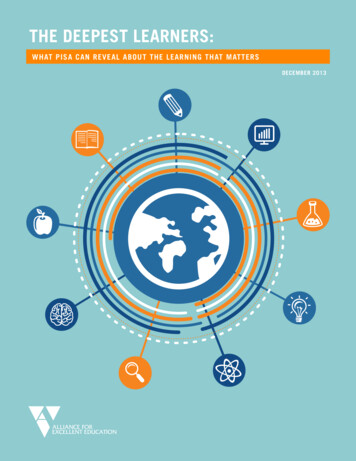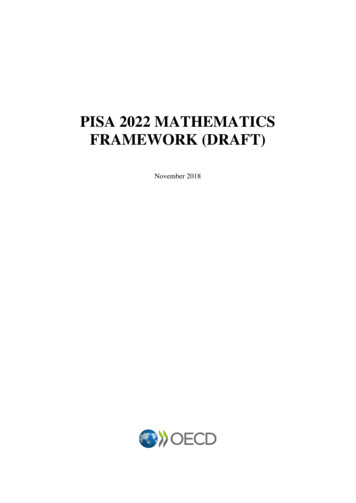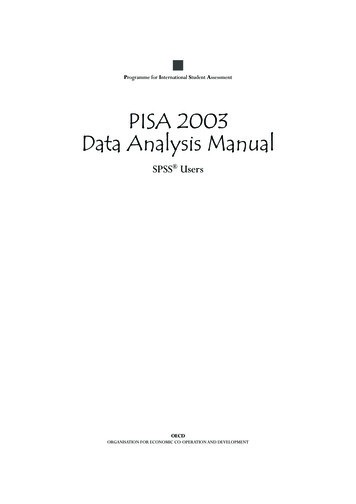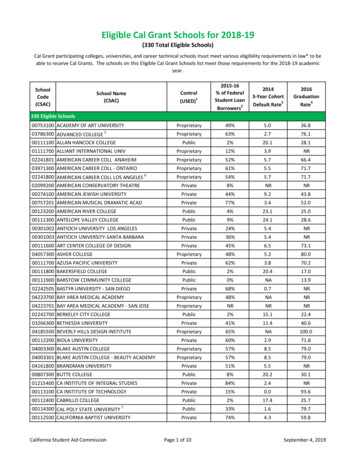
Transcription
PISA-BASED TEST FOR SCHOOLS SAMPLE TEST ITEMSThe OECD released a selection of sample test items from the assessment in an interactive, onlineformat. The sample test items include questions at each proficiency level for each testing domain(reading, mathematics and science). These items were not used in the actual assessment, but theywere used in the pilot of the assessment. This document contains the items used to populate thesample test items website, which allows users to answer these PISA-based Test for Schools questions,discover their level of difficulty, and the concepts being tested.
READINGQUESTION LEVEL 1: FREEFREE! BUT AT WHAT PRICE?Imagine you are in a shop and you are offered a choice of two gift vouchers. Which onewould you go for? Try to decide quickly! A 10 gift voucher for FREE! A 20 gift voucher for 7If your first instinct is the same as absolutely everyone in a study carried out by Shampan'erand Ariely in 2006, you'll take the first option, the free option. Economically, though, thisdoesn't make any sense. When you look at it you can see that the 20 gift voucher isactually better value: you really get a 13 gift voucher for free. However, this is camouflagedby the way the offers are worded. The word “free” just shakes all rationality out of us.Now compare these two offers and decide which you'd prefer: A 10 gift voucher for 1 A 20 gift voucher for 8Now if you're like the majority of people (64%) in Shampan'er and Ariely's study you'll go forthe 20 gift voucher.Notice that this time the price of each gift certificate has only been increased by 1. The 10gift voucher has gone from 0 to 1 and the 20 gift voucher has gone from 7 to 8. Yetwithout the word 'free', most people suddenly realise that the 20 deal is superior, anddecide to pay out for a better return.So be aware of the seductive power that 'free' holds over your mind and you might decideyou’d rather pay the priceQUESTIONAccording to the text, what effect does the word “free” have on consumers’ ability to makedecisions?ABCDIt prevents them from making decisions.It slows down their decision-making.It makes their decisions more thoughtful.It makes their decisions less thoughtful.2
READINGPRINT READING QUESTION (LEVEL 1)THE CORRECT ANSWER IS:(D) – IT MAKES THEIR DECISIONS LESS THOUGHTFUL.QUESTION LEVELStudents at Proficiency Level 1 are capable of locating pieces of explicitly stated information thatare rather prominent in the text, recognising a main idea in a text about a familiar topic, andrecognising the connection between information in such a text and their everyday experience.Typically the required information in texts at this level is prominent and there is little, if any,competing information. The reader is explicitly directed to consider relevant factors in the taskand in the text.NATURE OF THE TASKDraw inferences to identify the main idea in an expositionThe situation is personal. The question belongs to the exposition text type category because it isthe type of text in which the information is presented as composite concepts or mentalconstructs, or those elements into which concepts or mental constructs can be analysed.READING ASPECTThe aspect is integrate and interpret – form a broad understanding because the individual hasto focus on relationships within the whole text.SCORINGFull credit: D. It makes their decisions less thoughtful.No credit: Other or missing.3
READINGQUESTION LEVEL 2: INDIAN MYSTICIndian Mystic Claims Not to Eat for 70 YearsBy Benamin Radford, LiveScienceAn 82-year-old man in India is claiming to have not had anything to eat or drink since 1940 — anddoctors from the Indian military are allegedly studying him to learn his secret.The man, Prahlad Jani, is being observed in a Gujarat hospital. Jani claims to be a breatharian —someone who does not need to eat or drink, because he draws nourishment from the air and frommeditation.As remarkable as his story is, Jani is not the first, nor the only, person to claim such a supernaturalpower. The claim that people can live without food or water is called inedia, and is actually somewhatof a common claim among religious fakirs of India. Unfortunately, none of the cases have withstoodscientific scrutiny. The human body needs both food and water to function; it's as simple as that.It's easy for anyone to claim that he or she has not had anything to eat or drink for the past few weeksor months (or years). But unless the person has been carefully and continuously watched during thattime, it's impossible to prove the assertion.Several people who have claimed to survive without food or water were later caught eating anddrinking. It can take only a few seconds to eat something, and other than in specific areas such asprisons, conducting a close around-the-clock surveillance on a person is not easy. Often the personwill ask for privacy to sleep or go to the bathroom (which is suspicious in its own right) — and thensnack surreptitiously. One well-known breatharian advocate in the 1980s, a man named WileyBrooks, claimed he did not eat yet was caught consuming junk food.This is not the first time that Jani has made this claim. He was examined in 2003 for about a week,during which time, he apparently did not eat or exercise — but he did lose weight. If Jani's abilities arereal, it seems odd that he would lose weight during the time that his food intake was being monitored.If he truly gets all the sustenance he needs from air and meditation, there's no reason he would loseweight when he doesn't eat.Reports claim that Prahlad Jani "has now spent six days without food or water under strictobservation and doctors say his body has not yet shown any adverse effects from hunger ordehydration." Assuming the claim is true — and it's not clear just how strict the observation is —Jani's inedia so far remains unproven. If he really doesn't need food or water, he should be underclose observation for months or years to prove it. Given that he claims not to have consumedanything since World War II, this shouldn't be a problem.QUESTIONWhat is the author’s attitude towards the idea that people can survive without food andwater? Give a reason for your answer by using information from the article.Type your answer here:4
READINGPRINT READING QUESTION (LEVEL 2)THE CORRECT ANSWER:REFERS TO THE IDEA THAT THE AUTHOR DOES NOTBELIEVE IN INEDIA AND PROVIDES EVIDENCE TOSUPPORT THIS.QUESTION LEVELStudents at Proficiency Level 2 are capable of tasks that require the reader to locate one or morepieces of information, which might need to be inferred and might need to meet severalconditions. Other tasks at this level require recognising the main idea in a text, understandingrelationships, or construing meaning within a limited part of the text when the information is notprominent and the reader must make low-level inferences. Tasks at this level may involvecomparisons or contrasts based on a single feature in the text. Typical reflective tasks requirereaders to make a comparison or several connections between the text and outside knowledge,by drawing on personal experience and attitudes. PISA considers Level 2 a baseline level ofproficiency at which students begin to demonstrate the reading skills and competencies that willallow them to participate effectively and productively in life as they continue their studies, and asthey enter into the labour force and become members of society.NATURE OF THE TASKIdentify an author’s attitude in a persuasive textThe situation is personal. The question belongs to the argumentation text type category becauseit is the type of text that presents the relationship among concepts or propositions. Argumenttexts often answer why questions.READING ASPECTThe aspect is integrate and interpret – develop an interpretation because the individual has tofocus on relationships between parts of the text.SCORINGFull credit: Refers to the idea that the author does not believe in inedia and provides evidence tosupport this. May quote directly from the text.No credit: Gives an insufficient or vague response; shows inaccurate comprehension of thematerial or gives an implausible or irrelevant response; or missing.5
READINGQUESTION LEVEL 3: WRITING A TRAVEL ARTICLELet’s say I want to write an article expressing my conviction that Croatia is the next bigdestination for travellers. First, I’d ask myself why I feel this way. Well, let’s see: it’s beautiful,it has a rich history, the people are warm and it’s great value. I’ve isolated four salient pointsto support my theme, so the next question is order of importance.To organise my story in terms of accelerating emotional connection, I’ll lead with the pointabout value for money as it’s the least emotional and most practical or logical consideration.History begins to involve the heart but is still fundamentally intellectual, so that would besecond. Beauty is a more emotional consideration, drawing readers into the story via theirsoul. The people connection represents what I think is the climax of my trip, and the climaxof travel itself, so that would come last. My final point is the top of the pyramid, but everystep along the way contributes to my story’s overall resonance and effectiveness.Next, I’ll search through my notes and draw out the experiences that brought these points tolife. The hostel in Dubrovnik that cost just 15 a night, or that extraordinary meal under thestars that was 5. That’s where I learned how inexpensive the place was, relativelyspeaking. The historical richness of the country came to life in Dubrovnik, when I walkedalong the walls of the old city and saw old roof tiles shattered during the war lying side byside with new roof tiles built to replace them – a poignant reminder of the constant presenceof the past, but also an inspiring example of how tourism can help rebuild a place.Croatia’s beauty was obvious: the rocky coast and the shadowing cypresses, the wildflowersin bloom and not a person in sight.And then it all came together for me on my last night in Dubrovnik, when I went out to dinnerwith a local tour guide and she told me about how her family had suffered during the war,how the entire country had suffered, but there was now new hope blooming in the land.On reviewing these experiences, I realise that the historic part of the piece has moreemotional resonance for me than the beautiful landscape. And so, I rearrange the segments.I start with the process, then move on to the beauty and the history, and end with my mealwith the tour guide. I’ll have to make sure I pay attention to the transitions between thesections, but the piece is already taking shape in my mind. I’ve figured out how to structurethe middle, and now it’s just a question of bringing the individual examples to vivid life.QUESTIONWhich of these factors does the writer consider most important when writing a travel pieceabout Croatia?ABCDThe amount of detail that is provided for each personal story.The extent to which each experience described was personally moving.The way that the story moves between history and the present day.The way that the story links the distressing and rewarding experiences.6
READINGPRINT READING QUESTION (LEVEL 3)THE CORRECT ANSWER:(B) THE EXTENT TO WHICH EACH EXPERIENCEDESCRIBED WAS PERSONALLY MOVING.QUESTION LEVELStudents at Proficiency Level 3 are capable of reading tasks of moderate complexity, such aslocating multiple pieces of information, making links between different parts of a text, and relatingit to familiar everyday knowledge. Tasks at this level require the reader to locate, and in somecases recognise the relationship between, several pieces of information that must meet multipleconditions. Interpretative tasks at this level require the reader to integrate several parts of a textin order to identify a main idea, understand a relationship, or construe the meaning of a word orphrase. They need to take into account many features in comparing, contrasting or categorising.The required information might not be prominent or there may be too much competinginformation, or there might be other obstacles in the text, such as ideas that are contrary toexpectation or that are negatively worded. Reflective tasks at this level might requireconnections, comparisons, and explanations, or they might require the reader to evaluate afeature of the text. Some reflective tasks require readers to demonstrate a fine understanding ofthe text in relation to everyday knowledge. Other tasks do not require detailed textcomprehension but require the reader to draw upon less common knowledge.NATURE OF THE TASKInterpret the main factor involved in organising an articleThe situation is educational. The question belongs to the instruction text type category because itis the type of text that provides directions on what to do. The text presents directions forcertain behaviours in order to complete a task (e.g. a recipe, a series of diagrams showing aprocedure for giving first aid, and guidelines for operating digital software).READING ASPECTThe aspect is integrate and interpret – form a broad understanding because the individual hasto focus on relationships within the whole text.SCORINGFull credit: B. The extent to which each experience described was personally moving.No credit: Other responses or missing.7
READINGQUESTION LEVEL 4: LOST AT SEALOST AT SEADawn did not break slowly, as it does on land. The sky turned pale, the first starsdisappeared, and I went on looking, first at my watch and then at the horizon. The contoursof the sea began to appear. Twelve hours had passed, but it didn’t seem possible. Nightcouldn’t be as long as day. You have to have spent the night at sea, sitting in a life raft andlooking at your watch, to know that the night is immeasurably longer than the day. But soondawn begins to break, and then it’s wearying to know it’s another day.That occurred to me on my first night in the raft. When dawn came, nothing else mattered. Ithought neither of water nor of food. I didn’t think of anything at all, until the wind turnedwarmer and the sea’s surface grew smooth and golden. I hadn’t slept a second all night, butat that moment it seemed as if I’d just awakened. When I stretched out in the raft my bonesached and my skin burned. But the day was brilliant and warm, and the murmur of the windpicking up gave me a new strength to continue waiting. And I felt profoundly composed inthe life raft. For the first time in my twenty years of life, I was perfectly happy.The raft continued to drift forward – how far it had gone during the night I couldn’t calculate –but the horizon still looked exactly the same, as if I hadn’t moved a centimetre. At seveno’clock I thought of the destroyer. It was breakfast time. I imagined my shipmates seatedaround the table eating apples. Then we would have eggs. Then meat. Then bread andcoffee. My mouth filled with saliva and I could feel a slight twisting in my stomach. To takemy mind off the idea of food, I submerged myself up to my neck in the bottom of the raft. Thecool water on my sunburned back was soothing and made me feel stronger. I stayedsubmerged like that for a long time, asking myself why I had gone with Ramón Herrera tothe stern deck instead of returning to my bunk to lie down. I reconstructed the tragedyminute by minute and I decided I had been stupid. There was really no reason I should havebeen one of the victims: I wasn’t on watch, I wasn’t required on deck. When I concluded thateverything that had happened was due to bad luck, I felt anxious again. But looking at mywatch calmed me down. The day was moving along quickly: it was eleven-thirtyQUESTIONHow does the sailor try to cope with his experiences throughout the passage?ABCDBy staying alert.By avoiding worry.By remembering what happened.By trying to forget the past.8
READINGPRINT READING QUESTION (LEVEL 4)THE CORRECT ANSWER IS:(B) BY AVOIDING WORRY.QUESTION LEVELStudents at Proficiency Level 4 are capable of difficult reading tasks such as locating embeddedinformation, construing meaning from linguistic nuances and critically evaluating a text. Tasks atthis level that involve retrieving information require the reader to locate and organise severalpieces of embedded information. Some tasks at this level require interpreting the meaning ofnuances in a section of text by taking into account the text as a whole. Other interpretative tasksrequire understanding and applying categories in an unfamiliar context. Reflective tasks at thislevel require readers to use formal or public knowledge to hypothesise about or critically evaluatea text. Readers must demonstrate an accurate understanding of long or complex texts whosecontent or form might be unfamiliar.NATURE OF THE TASKIdentify a character’s overall response to a situationThe situation is personal. The question belongs to the narration text type category because it isthe type of text where the information refers to properties of objects in time. Narrationtypically answers questions relating to when, or in what sequence.READING ASPECTThe aspect is integrate and interpret – form a broad understanding because the individual hasto focus on relationships within the whole text.SCORINGFull credit: B. By avoiding worry.No credit: Other responses or missing.9
READINGQUESTION LEVEL 5: WELL-BEING IN THE UNITED STATESIn 2008, a survey investigated the well-being of people in the United States in relation totheir age. The telephone survey involved more than 340,000 people, aged from 18 to 85.The figures below show some of the results.10
GLOBAL WELL-BEING6.2 6.4 6.6 6.87Survey participants were asked to rank theiroverall life satisfaction on a 10-point scale.This became their “global well-being” score.HEDONIC WELL-BEINGSurvey participants were also asked six yesor-no questions aimed at establishing their“hedonic wellbeing”, which is a person’simmediate experience of a psychologicalstate. These questions asked whetherparticipants had experienced particularfeelings for a long period of time the previousday (enjoyment, happiness, stress, worry,anger, sadness). According to researchers,such answers are free from the revisedmemories or subjective judgements that thequestion about overall life satisfaction B Ladder7.2 7.4 7.6READINGAge8Information was also collected aboutparticipants’ gender, personal finances,health and other ment910Figure 1: Global Well-being(overall life 8512Stress45Figure 2: Results for Enjoyment(a component of hedonic well-being)AgeFigure 3: Results for Stress(a component of hedonic well-being)QUESTION11
READINGIn order to get the information shown in Figure 3, which of these questions might theresearchers have asked the participants during the telephone survey?ABCDOn a scale of 1 to 10, how much stress did you experience yesterday?At what time of the day yesterday did you experience stress?Did you experience stress for a large part of the day yesterday?At what age did you experience most stress?12
READINGPRINT READING QUESTION (LEVEL 5)THE CORRECT ANSWER IS:(C) DID YOU EXPERIENCE STRESS FOR A LARGE PARTOF THE DAY YESTERDAY?QUESTION LEVELStudents at Proficiency Level 5 can handle texts that are unfamiliar in either form or content.They can find information in such texts, demonstrate detailed understanding, and infer whichinformation is relevant to the task. They are also able to critically evaluate such texts and buildhypotheses about them, drawing on specialised knowledge and accommodating concepts thatmight be contrary to expectations. An inspection of the kinds of tasks students at Level 5 arecapable of suggests that those who get to this level and Level 6 can be regarded as potential“world class” knowledge workers of tomorrow.NATURE OF THE TASKIdentify explicitly stated information reworked in a question formatThe situation is public. The question belongs to the exposition text type category because it isthe type of text in which the information is presented as composite concepts or mentalconstructs, or those elements into which concepts or mental constructs can be analysed.READING ASPECTThe aspect is integrate and interpret – develop an interpretation because the individual has tofocus on relationships between parts of the text.SCORINGFull credit: C. Did you experience stress for a large part of the day yesterday?No credit: Other responses or missing.13
READINGQUESTION LEVEL 6: WELL-BEING IN THE UNITED STATESIn 2008, a survey investigated the well-being of people in the United States in relation totheir age. The telephone survey involved more than 340,000 people, aged from 18 to 85.The figures below show some of the results.14
GLOBAL WELL-BEING6.2 6.4 6.6 6.87Survey participants were asked to rank theiroverall life satisfaction on a 10-point scale.This became their “global well-being” score.HEDONIC WELL-BEINGSurvey participants were also asked six yesor-no questions aimed at establishing their“hedonic wellbeing”, which is a person’simmediate experience of a psychologicalstate. These questions asked whetherparticipants had experienced particularfeelings for a long period of time the previousday (enjoyment, happiness, stress, worry,anger, sadness). According to researchers,such answers are free from the revisedmemories or subjective judgements that thequestion about overall life satisfaction B Ladder7.2 7.4 7.6READINGAge8Information was also collected aboutparticipants’ gender, personal finances,health and other ment910Figure 1: Global Well-being(overall life 8512Stress45Figure 2: Results for Enjoyment(a component of hedonic well-being)AgeFigure 3: Results for Stress(a component of hedonic well-being)QUESTION15
READINGThis research shows how satisfieddifferent age groups are, but it can’tsay anything about why this is thecase.Is this a fair comment?Click “Yes” or “No” and explain your answer.YesNoType your answer here:.16
READINGPRINT READING QUESTION (LEVEL 6)THE CORRECT ANSWER:ANSWERS OR IMPLIES NO, AND REFERS TO THEPURPOSE OF COLLECTING ADDITIONAL PERSONALINFORMATION FROM THE PARTICIPANTS.QUESTION LEVELStudents at Proficiency Level 6 are highly skilled readers. They can conduct fine-grainedanalyses of texts, which require detailed comprehension of both explicit information and unstatedimplications, and they can reflect on and evaluate what they read at a more general level.Students at this level have successfully completed most of the tasks presented to them in thereading assessment, demonstrating that they are capable of dealing with many different types ofreading material. Hence, they are diversified readers who can assimilate information fromunfamiliar content areas presented in atypical formats, as well as being able to engage with morefamiliar content with typical structures and text features. Another characteristic of the most highlydeveloped readers is that they can overcome preconceptions in the face of new information,even when that information is contrary to expectations. Students at this level are capable ofrecognising what is provided in a text, both conspicuous and more subtle information, whilebeing able to apply a critical perspective to it, drawing on sophisticated understanding beyondthe text.NATURE OF THE TASKUse information from a report to evaluate a criticism of the reportThe situation is public. The question belongs to the exposition text type category because it isthe type of text in which the information is presented as composite concepts or mentalconstructs, or those elements into which concepts or mental constructs can be analysed.READING ASPECTThe aspect is integrate and interpret – develop an interpretation because the individual has tofocus on relationships between parts of the text.SCORINGFull credit: Answers or implies No, and refers to the purpose of collecting additional personalinformation from the participants.No credit: Answers or implies No without any explanation or with an implausible, irrelevant orvague explanation; Answers or implies Yes; Shows inaccurate comprehension of the material orgives an implausible or irrelevant answer; or missing.17
MATHEMATICSQUESTION LEVEL 1: IRON-ON IMAGEJosh designs images for t-shirts on his computer. He prints the images using special paper.The image is then ironed onto the t-shirt.The final image on the t-shirt is a mirror image of the design on the computer.Printed on paperDesigned on computerIroned onto t-shirtQUESTIONThis picture shows a new design Josh printed onto paper.How will the design appear on the t-shirt?ABCD18
MATHEMATICSMATHEMATICS QUESTION (LEVEL 1)THE CORRECT ANSWER IS:(B)QUESTION LEVELStudents at Proficiency Level 1 can answer questions involving familiar contexts where allrelevant information is present and the questions are clearly defined. They are able to identifyinformation and to carry out routine procedures according to direct instructions in explicitsituations. They can perform actions that are obvious and follow immediately from the givenstimuli.NATURE OF THE TASKIdentify the reflection of an abstract imageThe context is occupational. The question belongs to the space and shape content category,which encompasses a wide range of phenomena that are encountered everywhere in ourvisual and physical world: patterns, properties of objects, positions and orientations,representations of objects, decoding and encoding of visual information, navigation anddynamic interaction with real shapes as well as with representations.MATHEMATICAL PROCESSThe process is employing mathematical concepts, facts, procedures and reasoning becausethe individual has to apply mathematical concepts, facts, procedures, and reasoning to solvemathematically-formulated problems to obtain mathematical conclusions.SCORINGFull credit: B. (graphic)No credit: Other responses or missing.19
MATHEMATICSQUESTION LEVEL 2: FREE TICKETSA radio station has 10 free tickets to a concert to give away.Each listener may send in one email requesting a ticket.Emails are received from 1200 listeners.Emails are then selected at random one at a time until all tickets are given away.QUESTIONThe first 9 tickets have been given away.John’s email has not been selected.What is John’s chance of winning the last ticket?John’s chance 1 in .20
MATHEMATICSMATHEMATICS QUESTION (LEVEL 2)THE CORRECT ANSWER IS:1191 OR WORKING THAT SHOWS 1 1191QUESTION LEVELStudents at Proficiency Level 2 can interpret and recognise situations in contexts that require nomore than direct inference. They can extract relevant information from a single source and makeuse of a single representational mode. Students at this level can employ basic algorithms,formulae, procedures, or conventions. They are capable of direct reasoning and literalinterpretations of the results. PISA considers Level 2 a baseline level of mathematics proficiencyat which students begin to demonstrate the kind of skills that enable them to use mathematics inways that are considered fundamental for their future development.NATURE OF THE TASKCalculate conditional probability of an eventThe context is societal. The question belongs to the uncertainty and data content category, whichincludes recognising the place of variation in processes, having a sense of the quantificationof that variation, acknowledging uncertainty and error in measurement, and knowing aboutchance.MATHEMATICAL PROCESSThe process is formulating situations mathematically because the individual has to recogniseand identify opportunities to use mathematics and then provide mathematical structure to aproblem presented in some contextualised form.SCORINGFull credit: 1191 or working that shows 1 1191No credit: Other responses or missing.21
MATHEMATICSQUESTION LEVEL 3: WHICH FORMULA?Steph and Jawad run their own businesses.Steph makes greeting cards and sells them at a market eachSunday.Jawad is a gardener.QUESTIONJawad’s total charge for a gardening job is: a fixed charge of 20 zeds plus an hourly charge of 30 zeds per hour.Write a formula that shows how Jawad’s total charge, C, relates to, h, the number of hourshe spends on a job?NOTE: PISA questions often refer to situations that take place in the fictional country ofZedland, where the Zed is the unit of currency.Type your response here: 22
MATHEMATICSMATHEMATICS QUESTION (LEVEL 3)THE CORRECT ANSWER IS:AN EXPRESSION THAT SHOWS AN UNDERSTANDINGOF THE RELATIONSHIP BETWEEN TOTAL CHARGE,FIXED CHARGE, HOURLY CHARGE AND HOURS(E.G., C 30H 20; C 20 H x 30)QUESTION LEVELStudents at Proficiency Level 3 can execute clearly described procedures, including those thatrequire sequential decisions. They can select and apply simple problem-solving strategies.Students at this level can interpret and use representations based on different informationsources and reason directly from them. They can develop short communications reporting theirinterpretations, results and reasoning.NATURE OF THE TASKCreate a correct formula in a context based on a linear relationship between fixed and variablecostsThe context is occupational. The question belongs to the change and relationships content area,which involves understanding fundamental types of change and recognising when they occurin order to use
PISA-BASED TEST FOR SCHOOLS SAMPLE TEST ITEMS The OECD released a selection of sample test items from the assessment in an interactive, online format. The sample test items include questions at each proficiency level for each testing domain (reading, mathematics and science). The










